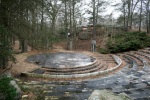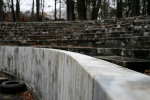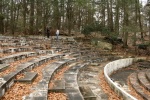“If you build it, they will come. ” I imagine Horton O’Neil had a similar calling to that of Ray Kinsella in Field of Dreams. Why else would he build a full size Greek style amphitheatre entirely out of marble in the woods of his Cos Cob home? Well, Mr. O’Neil was not expecting the ghosts of Demosthenes and Plato, but he did expect to entertain his family and friends.I got an opportunity to tour the famous marble theater that lay hidden under my nose all these years. How many times have I driven down the causeway on Valley Road and never known that it even existed. So, along with my brother, we drove through the cut in the ledge rock, just off Valley Road into Lia Fail. Pronounced “lee-ah fi-yeel”, and translated from Gaelic as “Stone of Destiny,” the magical place in Ireland was home to a line of kings that bore the O’Neil name. As we knocked on the door of the cozy cottage, we peered through the woods to catch a glimpse of this hidden treasure. We were met by our hostess, the lovely and informative Florence, who lives in the small house just through a short path in the woods to the amphitheatre. Like a museum docent, Florence enlightened us with the history of this magical place. She led us down the path, and with excitement we came out of the thicket and this Greek amphitheatre opened up in front of and spread out below us. Although dirty with moss and algae and covered with leaves due to unuse, the once white marble underneath is still visible, it was breathtaking. It has the effect of a bowl, and was built without blasting as it is constructed into the side of the hill. The hemlocks behind the stage acted as a natural backstage screen that kind of “softened the edges.”
Imbued with a love of the theater by his father, architect Horton O’Neil began construction on the amphitheatre in 1934, and completed it in 1937. One truck, two laborers, two stone cutters and himself, this small crew used marble from two quarries in Vermont, one in Wingdale, New York, and another via a stone yard in Brooklyn. Some of the marble was originally milled for Arlington Cemetery, but was rejected by the government. Each piece is tapered and custom cut like pieces of a pie,and fit together to create the circular effect. Like the classic Greek amphitheatres, there is a “moat” separating the stage from the audience, this was to be used as an orchestra pit. In the end, the theatre seated about 500. There were a few minor accidents along the way during construction, but all in all, no one was seriously hurt.
The theater was christened in the Spring of 1938 with conductor Quinto Maganini rehearsing his Norwalk Symphony Orchestra. The theatre had a more informal history though, in it’s early years being used by the elder O’Neil for dramatic poetry readings for family and friends. During World War Two, Horton and his wife moved to Portland Me, where he worked in a shipyard, and the amphitheatre was unused.
The theatre got its most robust use from the dancers from Greenwich Academy, who had the theatre filled on five or six occasions from 1949-1959.
Horton was married to Madelyn, an educated modern dancer who studied under such greats as Martha Graham. She later took over the role of the head of Grrenwich Academy Dance and had some of her group’s performances at the theatre. In the early 70’s Cos Cob Elementary performed a classical Greek play, second graders in togas and all. (This was Florence’s project, which she has well documented with a great photo album.)
An interesting note is that the theatre had better acoustics filled with people than it did empty, this was due to the reverbation off of the marble.
Originally a 30-acre compound owned by The O’Neils, it eventually became divided and more homes were built on the property. In the 60’s, reality set in, and the neighbors turned against the use of the amphitheatre. They worried about “zoning” and where people would park. Although it never had a regular performance schedule, and was not used very often, it was probably “too eccentric” for most.
It seems like this amazing piece of lost local history has reached the end of its road. Because what is a theatre if is not used, or filled with a delighted audience, whether 5 or 500.
The last link to the O’Neils and the living amphitheatre is Florence, who for a few moments one afternoon, was able to sweep away the leaves and clean off the moss, and make this theatre gleaming white again filled with people like us enjoying the show.
Thanks to Florence and to the Oral History by Horton and Madelyn O’Neil, as interviewed by Nancy Wolcott.














